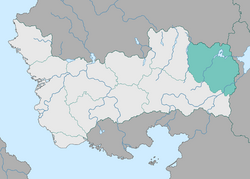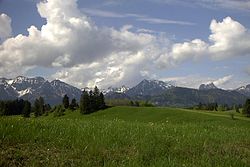Elland: Difference between revisions
Pokemarick (talk | contribs) (Created page with "Category:Provinces category:Empire of the Trident category: Hellona {{Infobox Settlement |name = Elland |native_name = ''Ellän''...") |
Pokemarick (talk | contribs) No edit summary |
||
| Line 1: | Line 1: | ||
[[Category:Provinces]] [[category:Empire of the Trident]] [[category: Hellona]] | [[Category:Provinces]] [[category:Empire of the Trident]] [[category: Hellona]] | ||
{{Infobox | {{Infobox settlement | ||
|name = Elland | |name = Elland | ||
|native_name = ''Ellän'' | |native_name = ''Ellän'' | ||
Revision as of 20:45, 1 May 2019
Elland
Ellän | |
|---|---|
Province of Hellona | |
|
| |
 | |
| Capital and largest city | Rökavik |
| Government | |
| • King's Commissioner | Håkon Bjornson |
| • Rank | 4th |
| Population (1888) | |
| • Total | 1,792,000. |
| • Rank | 1st |
| • Density | 19,820/km2 (51,300/sq mi) |
| • Rank | 1st |
| Demonym | Ellandic |
| Abbreviation | ELS |
| Website | https://www.Elland_Hel.hlo/ |
Elland (Hellonian: Gewest Elland, Ellandic: Landskap Ellän) is a province in north-eastern Hellona. It is bordered by the provinces of Halleren on the east, and Moesland on the south.
Elland was long ago its own kingdom until it was conquered by Hellona in the 1st century. Elland still has its own language Ellandic, and culture. Ellandic culture has spread to Halleren and the Hellonian colony of Norsund, where it became dominant under the settlers. The capital and seat of the provincial government is Rökavik, the province's largest city. The King's Commissioner of Elland is Håkon Bjornson. There are 11 municipalities.
Etymology
Elland comes from the Ellandic word eld, meaning fire. The name was used by the first dynasty of Ellandic kings to show their strength and might. The kingdoms name changed from Eld to Ellas to differentiate it from the word itself. Eld was later changed into the current ild to differentiate it even more from the country, mostly from pushes from the Hellonian government at the time. Elland/Ellän came into use around the 15th century, because of a sound change in the Ellandic language.
History
Prehistory
Traces of life can be found in the mountainous ranges of Elland, of around 1.6 million years ago. After the last ice age, modern men came to Elslo, where the Ellänninger tribe began. This tribe was seclusive and had built itself in isolation for hundreds of years. The kingdom of Elland officially started around 1000 B.C Slowly growing to encompass the whole north-east of modern Hellona. Elland was divided into four provinces with great self-governance.
Andusian conquest
This era of Hellonian history is characterized by the many wars and the constant warfare between the Andus kingdom and the local populations of the many different states in the Hellonic region, including: the Rejkish city-states, the Duchy of Melre, the Realm of Alland, the Princedom of the Plaeten, the Sakensberg city-state federation, the Kingdom of Guldeland, the Republic of the Moeslanden, the United Chieftains of Rines, the City State of Brunhilde, the Tribes of the Centralberg and the Kingdom of Elland. These wars are often called the Andusian wars of Conquest. Andus under Björn Wodanerson kept winning in grand battles, leading one conquest after another. Ones the Andusian troops conquered Guldeland and were at distance from Elland, the Ellandic king Harald decided it was best to give up the Ellandic independence for peace. He offered his daughter, princess Viktoria Gyllenhjärt, to be wed to the Andusian hero-king Wodanerson. The Kingdom of Hellona was first formed by this act of union, and the modern royal family was formed. Wodanerson wanted to expand further, but decided to stop the march east after a failed expedition through the Centraberg mountain range.
After king Haakon died, the Ellandic kingdom was officially disbanded.
Geography
Elland is located in the Ellandic mountain range, and has a oceanic to continental climate. More upwards there is a mountainous climate, with lower temperatures and greater precipitation. Most settlements are in the south, where the Elsloer valley (Hellonian:Elsloër-dal, Ellandic:Elsloer dal) is located, which houses the capital of Rökavik and many other cities. Other major inhabited places are found in the Middeldal (Ellandic: Mideldal)
Elland shares international borders with Arialucia. Neighbouring provinces in Hellona are Moesland and Halleren. The Centreberg mountain range defines the border with Halleren, which almost completely splits the two provinces apart.
Gemeentes (Municipalities)
As with other Hellonian provinces, Elland is further divided into municipalities, with 48 as of 8 January, 1894.
These municipalities are grouped in COROP groups. These regions are used for analytical purposes by, among others, Statistics Hellona. The Hellonian abbreviation stands for Coördinatiecommissie Regionaal Onderzoeksprogramma, literally the Coordination Commission Regional Research Programme.
COROP groups of Elland
- Elsoer valley COROP group
- Stekerbergen COROP group
- Middendal COROP group
- Centraberger COROP group
- Innerberger COROP group
Culture
Ellandic culture is distinct from Hellonian culture. Ellandic has its own distinctive culture, which can be found in respect to:
Religion
When Elland was still an independent kingdom, it had its own version of Bastation, which had already spread throughout Hellona. However when the Andusians conquered the region, most of the faith was lost and replaced with the normal state-bastation of Andus and later Hellona.
As of 1894, 82% of Ellandics follow the Hellonian version of Bastation. 4% follow the Arialucian Spaikism, mostly in the north-west and 14% is irreligious or adhere other religions.
Traditions
Ellandics emphasize pride in their traditions, more than any other of the provinces. Traditional costumes, called Bunad, are still worn with pride. They have distinctive festivals, like Frostdag, in which they celebrate the coming of snow and the goddess Vinåja, to the lower valleys. Other festivals like the midsommarstång are celebrated more than in other parts of Hellona, even though it's a part of Hellonian culture too.
The purity of rural Ellandic culture, compared to other Vismarian cultures, have captured many romanticists. This romanticized version of Ellandic culture is called Romantic Ellandism, which in turn was important to the Hellonian Romantic Nationalism from the 19th century and is still important to many Hellonians in modern day and age.
Language
Elland is the only province with its own language, Ellandic. Ellandic is a Vismaric language and is closely related to Hellonian. On Veterra; Ellandic is mostly spoken in Elland, with small percentages in Halleren and neighbouring provinces and countries. However, in Norsund, Ellandic became the prominent language because of mass immigration and is the official language used by the government.
The language of instruction in publicly financed schools is Ellandic, but most schools feature bilingual instructions in Hellonian.
Sports
Unlike other Hellonian provinces, the most popular sport is not football, but ice Hockey and curling, as the mountainous terrain didn't allow for much room for football stadiums. There are several ice hockey teams including Rökaviker HC, HC Jordskoppen and HC Spetsbergen, also called the Mounties. It is home to two professional football clubs, being FC Vinåja, who have won 4 Hellonian titles and SC Innerbergen, who have won no titles.
See also
Further reading
Geography and environment
- Bjornheim, Haakon Mountainous Hellona (1823)
- Pietrson, Sven A Geographical look on Elland (1875)
History
- Paul Gebabbel. A History of the Vismar region (1816)
- Kristoffer Ydrassil. History of Elland (1788)



